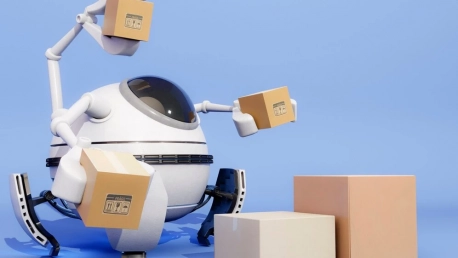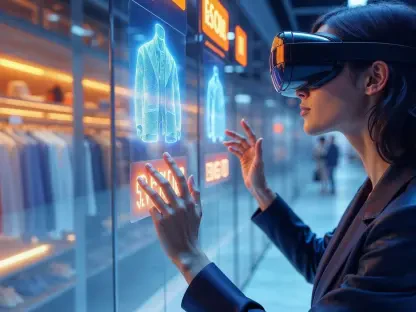In today’s retail landscape, the fusion of digital and brick-and-mortar experiences is epitomized by the advent of smart retail, driven by the Internet of Things (IoT). With consumers demanding more efficient and tailored shopping experiences, IoT is seen as the solution to a host of retail challenges. It promises to optimize inventory management, streamline checkout processes, and enhance customer engagement.IoT technology is at the forefront of transforming retail operations. By employing data gathered from various sensors and connected devices throughout the store, retailers can anticipate consumer needs, ensure that popular items are in stock, and prevent bottlenecks at payment counters. Additionally, personalized marketing efforts can be amplified with IoT by analyzing shopping patterns and preferences, leading to more meaningful consumer interactions.The integration of IoT in retail is not just a passing trend but a pivotal shift in how retailers interact with their customers and manage day-to-day operations. It stands at the threshold of redefining shopping as we know it, poised to delve deep into the fabric of consumer behavior and retail strategy. The reach and impact of IoT in retail will only grow as technology advances, making it an indispensable element in the future of retail and consumer engagement.
The Advent of Smart Retail Through IoT
The introduction of IoT has initiated an unparalleled metamorphosis in inventory management. Gone are the days of manual stock takes and guesswork. Today’s retail environment boasts shelves that communicate, tagging systems like RFID that whisper the whereabouts of goods, and sensors that signal the need for restocking. These advancements grant retailers an almost omniscient perspective of their inventory, on-demand and error-free. The precision afforded by real-time tracking not only ensures the prompt availability of products but significantly reduces the likelihood of out-of-stock scenarios, eradicating a major source of customer frustration.As if plucked from a science fiction novel, stores now have the eyes to see and analyze customer movements and behaviors. With Wi-Fi and Bluetooth beacons, retailers can discern which aisles attract the most traffic, the products that prompt lingering gazes, and the pathways often tread. This collection of data not only fuels the optimization of store layouts but also sharpens the precision of marketing efforts, carving out a shopping atmosphere that feels decidedly intuitive and delightfully inevitable.
Enhancing Customer Experience with Personalized Marketing
Among the most tantalizing prospects of IoT in retail is its capacity to personalize the shopping journey. Harnessing data on customer location and purchasing proclivities, retailers can now curate marketing messages with laser-focused accuracy. Imagine receiving a discount offer on your favorite brand the moment you step into the relevant aisle, or being guided by your smartphone to a new product that aligns with your tastes. This level of targeted engagement not only enhances the shopping experience but also fosters a sense of individual attention that can strengthen brand loyalty.But IoT’s role doesn’t end with personalized marketing; it extends to redefining the checkout process. Through advances like IoT-powered computer vision, shoppers can simply pick up their items and walk out, as systems automatically tally their purchases and charge their accounts. This emerging model of a cashierless experience promises to dissolve the annoyance of queues, embodying the very essence of what modern consumers crave—speed, convenience, and effortless transactions.
Optimizing Retail Operations and Supply Chain
IoT’s tentacles are not only transforming customer-facing facets of retail but are also overhauling back-end operations. Smart shelves equipped with weight sensors and RFID technology can detect stock levels down to the last item, alerting staff to replenishing needs or near-expiry goods. This proactive approach to inventory management not only curbs waste and spoilage but ensures the continuous availability of fresh and desirable products.On the supply chain front, IoT devices grant unparalleled visibility into the journey of products from warehouse to shelf. Retailers can track the condition and location of items in real-time, streamlining logistics and ensuring that goods arrive as scheduled and in saleable condition. Furthermore, IoT sensors adeptly manage energy usage based on occupancy and environmental factors, carving a path toward greener, cost-effective retail operations.
Data-Driven Decision-Making and Competitiveness
Armed with data harvested through IoT, retailers can wield the power of precision to make informed decisions. Every scan, click, and movement becomes a brushstroke in the larger picture of consumer habits. Retailers who embrace this data-centric approach can design experiences and stock shelves that resonate more deeply with their customers’ desires. The result is a shopping realm where convenience, preference, and availability align seamlessly, underpinning heightened levels of customer satisfaction and retention.Moreover, these intelligent systems play a pivotal role in upholding security. IoT devices serve as the sentinels of the store, offering advanced surveillance capabilities and inventory tracking that double as anti-theft measures. The implementation of these systems lays a solid foundation for safer shopping environments, contributing to the overall appeal of brick-and-mortar venues in the digital age.
Navigating IoT Challenges in Retail
For all its promise, the integration of IoT in retail is not without its tribulations. As retail becomes increasingly data-dependent, concerns about privacy and data security eclipse other obstacles. Retailers find themselves in a delicate dance of harnessing consumer data for better service while guarding it with stringent security measures. This balance is paramount to maintaining consumer trust and complying with ever-tightening regulations on data privacy.Smaller retailers, in particular, face a daunting challenge in the form of the cost associated with adopting IoT solutions. The pressure to demonstrate a return on investment looms large, necessitating calculated risks and smart financial planning. Even for those who cross the financial hurdle, interoperability issues linger, prompting calls for industry-wide standards to facilitate the smooth interaction of diverse IoT devices. And beyond technology itself, a cultural shift within retail organizations is requisite—a transformation that champions innovation and flexibly integrates new systems into the very fabric of retail operations.Despite the headwinds, the prowess of IoT in driving the future of smart retail is undeniable. As retailers chart their paths through the digital thicket, the ones who adeptly marry IoT with their business ethos stand to emerge not just as survivors, but as beacons of a new retail epoch.









